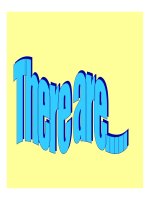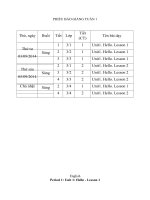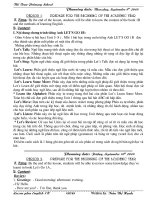- Trang chủ >>
- Sư phạm >>
- Sư phạm toán
giao an tieng anh lop 4 tuan 9
Bạn đang xem bản rút gọn của tài liệu. Xem và tải ngay bản đầy đủ của tài liệu tại đây (111.95 KB, 5 trang )
<span class='text_page_counter'>(1)</span>Week: 9 Period: 33. Date of teaching: 31/10/2016 Class 4A: Period 1 Class 4B: Period 3. Short story: Cat and Mouse 1 I. OVERVIEW Objectives: Language focus: Resources: II. PROCEDURE Steps 1. Warm-up. By the end of the lesson, sts will be able to read and understand the story and do some exercises. + New word + Structures: Ss’ book, recording, fresh cards, puppets, posters of the song We have English today. Learning activities Sing some songs.. Language focus. 2. Work in groups of three. Read …. - Tell Ps that they are going to practise the dialogues, using their own names. - Ask them to sit opposite of each other and practise the dialogue. - Call a few pairs to act out the dialogue. - Correct the pronunciation, if necessary. 1.d 2.a 3.e 5.b. 3. Unscramble the words …. - Tell Ps that they are going to put the letters in the correct order to make words , and that they can find the words in the story. Do the first word as an example. - Give them time to do the task. - Ask Ps to swap and check their answers before checking as a class. - Ask a few pairs to read aloud the correct words. -Have Ps revise the. Key: b. really c. nice d. friends e. guitar f. America. 4. Home link. Modes T-Whole class. 4.c Groups work. The whole class. Individually The whole class. Individual.
<span class='text_page_counter'>(2)</span> activities which they have learned.. Week: 9 Period: 34 TEST PART 1. LISTENING (15 minutes) PART 2. READING AND WRITING (20 minutes) PART 3. SPEAKING (5 minutes). Date of teaching: 31/10/2016 Class 4A: Period 2 Class 4B: Period 4.
<span class='text_page_counter'>(3)</span> Week: 9 Period: 35. Date of teaching: 02/11/2016 Class 4A: Period 1 Class 4B: Period 3 ANSWER OF TEST 1. PART 1. LISTENING (15 minutes) Task 1. Listen and tick. 1. A 2. A 3. A 4. B 5. A Task 2. Listen and tick or cross. 1. ✓ 2. ✓ 3. ✗ 4. ✓ 5. ✗ Task 3. Listen and draw lines 1.D 2.C 3. A. 4.E. 5.B. PART 2. READING AND WRITING (20 minutes) Task 1. Look and write. There is one example. 1. afternoon. 2. Japan. 3. Wednesday. 4. sixth. 5. skate. Task 2. Read and complete. 1. F. 2. B. 3. C. 4. A. 5. D. 3. Yes. 4. No. 5. Yes. Task 3. Read and write. 1. No. Week: 9 Period: 36. 2. No. Date of teaching: 02/11/2016 Class 4A: Period 2 Class 4B: Period 4.
<span class='text_page_counter'>(4)</span> Unit 6: Where’s your school? I. OVERVIEW Objectives:. By the end ofLesson this unit, can use the words and phrases related to the 1: pupils 1. Look, listen and repeat. topic School. 2. Point and say.. Ask and answer questions about where a school is, using Where’s your school? It’s in + (place). Language focus: Spoken interaction, words and structures/ function. - Sentence Patterns: What class are you in? I’m in class… Resources: Ss’ book, recording, fresh cards, puppets, posters, …. II. PROCEDURE Steps Learning activities Language Modes focus 1. Warm-up - Spend a few minutes revising the previous lesson Spoken Whole class by calling pupils to sing the Interaction. song This is the way. Have the class clap hands. 2. Look, listen & repeat. 3. Point & say. - Tell pupils that they are going to learn to ask and answer questions about where their school is. - Have them look at the four pictures to discuss the context in in which the language is used. Ask them questions such as Who are the pupils? Where are they? And What are they talking about? Spoken - Play the recording a few interaction times for pupils to listen and repeat. Do choral and individual repetition, pointing to the characters speaking - Play the recording again for pupils to listen and repeat. ***Language note: What about you? is used when people do not want to repeat the previous question. E.g.What about you, Jack? In Picture d means Where’s your school, Jack? - Tell pupils that they are going to practice asking and New words and answering questions about structures/ where a school is, using function Where’s your school? It’s in + (place). Whole class Individuals. Whole class. Individuals.
<span class='text_page_counter'>(5)</span> 4. Home link. - Have them look at the bubbles and the pictures to understand how the language is used in different contexts. Point to the first picture and teach the word Oxford Street. Get pupils to ask the question Where’s your school? and give the answer It’s in Oxford Street chorally and individually. Then tell them to practice asking and answering the question in pairs, using the prompts in the bubbles and the words under the picture. Repeat the same procedure with the rest of the pictures. - Invite a few pairs to act out the dialogue in front of the class. Check as a class and correct pronunciation. ***Language note: Use capital letters at the beginning of proper names. Work in pairs. Ask and answer questions about your school. Ask its name and where it is. - Tell pupils that they are going to say the name and location of their own school. - First, tell pupils to work in pairs: one pupil asks What’s the name of your school? Where is it? and the other answers My school is + (school). It’s in + (place). - Have pupils practice asking and answering the questions about the date .. Pairs. Groups. Individual.
<span class='text_page_counter'>(6)</span>









